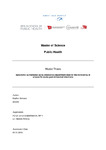Syndromic surveillance using emergency department data for the monitoring of unspecific acute gastrointestinal infections
Schranz, Madlen
Background: Timely detection is a prerequisite for the successful prevention and management of gastrointestinal infections. Complimentary to already existing surveillance systems, syndromic surveillance can be used for that purpose. This study analyses data from a piloted syndromic surveillance system in Germany, aiming at the definition of syndromes and the exploration of the system’s ability to monitor seasonal patterns and short-time aberrations of gastrointestinal infections. Methods: Routinely collected data from emergency departments were analysed. Within this paper, two Syndromic Surveillance Health Indicators (SySHI) were created in order to combine complaint information. Syndromes were defined based on a combination of SySHI and a set of ICD-10 diagnoses. Identified cases were stratified by emergency department, age and isolation status. Time series were used to analyse seasonal patterns and combined with an algorithm to perform aberration detection. Results: Between 2012 and 2019 data on 935,032 visits of ten emergency departments were analysed. Of those, 2.7% were identified as cases according to the Syndromic Surveillance Health Indicator. The syndrome definition “unspecific GI without bleeding” identified 3,329 and the syndrome definition “bloody diarrhoea” 589 cases. Time series analysis showed seasonal patterns with peaks in the winter months for the first syndrome. Exemplary for one hospital a total of six signals was created by the algorithm. Conclusion: Emergency department data can be used to define appropriate syndromes for the detection of seasonal patterns and aberrations in case numbers. Syndromes incorporating information on chief complaint and diagnosis were able to identify seasonal fluctuations of gastrointestinal infections.
Dateien zu dieser Publikation
Keine Lizenzangabe

